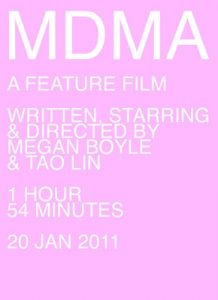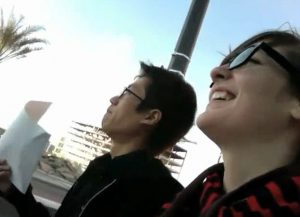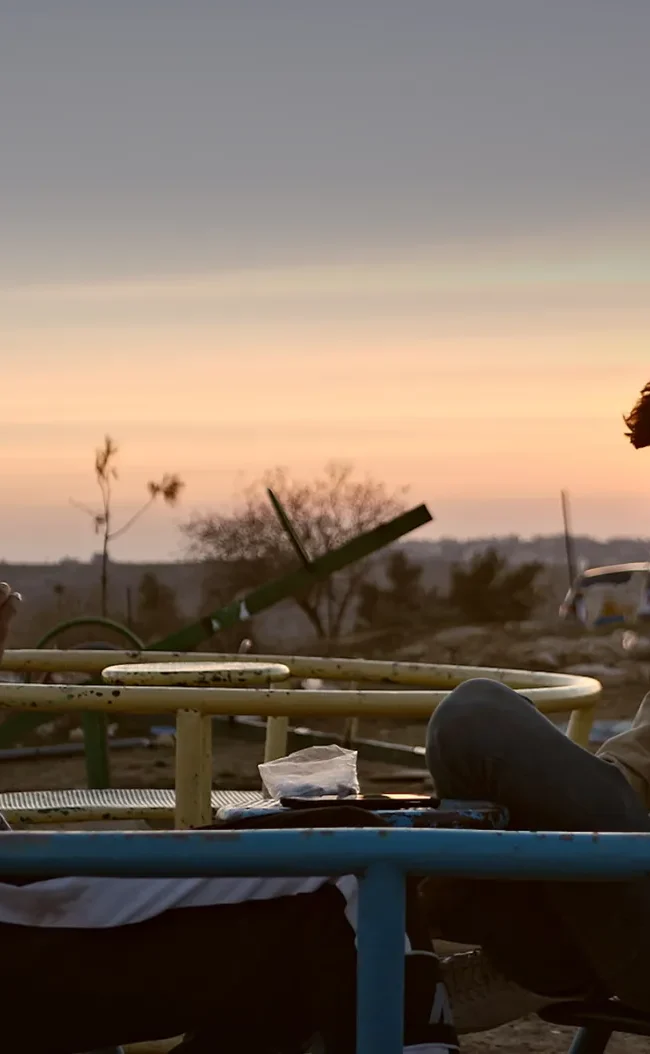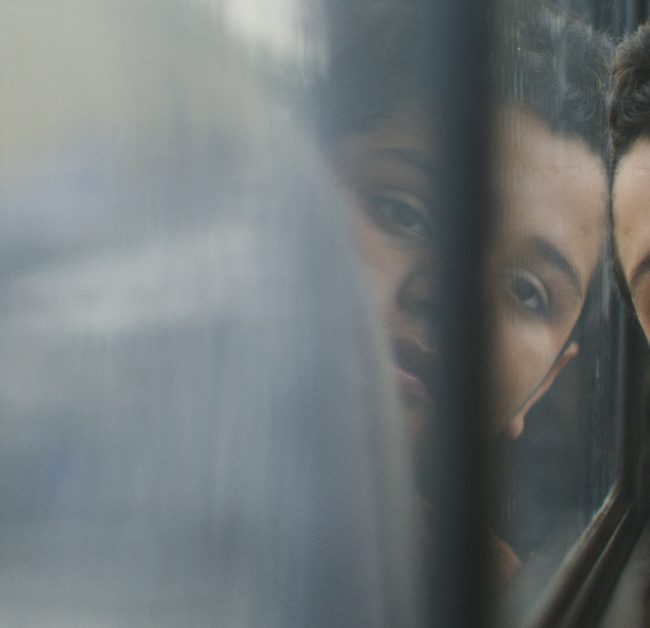Nick Toti’s “Digital Gods”- Season Two, Transmission Five
 MDMAfilms was, in practical terms, a short-lived but highly productive video production company created, operated, and consisting entirely of the young American authors Megan Boyle and Tao Lin. Technically, MDMAfilms never dissolved or officially stopped operating, but, to my knowledge, Boyle and Lin haven’t produced any movies together since 2011. In that one year, though, they released three feature-length, autobiographical, experimental documentaries, each one uniquely worthy of critical analysis, unified by the formal constraint (or gimmick, to the less generous) of being shot entirely on a MacBook.
MDMAfilms was, in practical terms, a short-lived but highly productive video production company created, operated, and consisting entirely of the young American authors Megan Boyle and Tao Lin. Technically, MDMAfilms never dissolved or officially stopped operating, but, to my knowledge, Boyle and Lin haven’t produced any movies together since 2011. In that one year, though, they released three feature-length, autobiographical, experimental documentaries, each one uniquely worthy of critical analysis, unified by the formal constraint (or gimmick, to the less generous) of being shot entirely on a MacBook.
This article will not dig into the content of MDMAfilms’s three features (though a follow-up article will, followed by a third article featuring a lengthy interview with Boyle and Lin). Instead, the focus here is on the context surrounding this body of work, specifically how it extends from the already established literary careers of the two author-turned-filmmakers involved.
There’s a loosely-connected tradition (calling it a genre or even sub-genre would be a stretch) in experimental cinema in which established literary figures take a break from writing to step behind the camera. The results have been incredibly varied, yet consistently interesting in ways that are alternately wildly imaginative (Cocteau), idiosyncratically erotic (Genet), batshit crazy (Mailer), dully transgressive (Murakami), and poetically clinical (Cooper). Though some of these cinematic efforts have been regarded as masterpieces, others are widely dismissed as the unwatchable indulgences of unchecked egos. This criticism is frequently totally valid, but, to the right viewer, these works are worth the sometimes considerable effort of sitting through. The qualities that make a great writer are very different from those that make a great filmmaker, but the awkward tension that can result from a refined literary talent struggling to express itself visually can be exquisite. You will simply never see another movie like Norman Mailer’s Maidstone. Seriously, I dare you to try.
The output of MDMAfilms can be viewed as an extension of the literary projects of both Boyle and Lin. The style of each author is distinct, but there is a significant amount of thematic and subject overlap. Both authors tend toward the autobiographical, though Lin frequently fictionalizes his work by changing the names of his characters. The most striking feature that the authors have in common is the almost masochistic compulsion to catalog the most potentially compromising/embarrassing/painfully personal details of their daily lives. The most dramatic illustration of this is Boyle’s upcoming book Liveblog, which consists of 700 densely packed pages attempting to detail every action, thought, feeling, drug, meal, sexual encounter, conversation, online interaction, and whatever else occurred in her life for about five months in 2013. Similarly, Lin has described his writing process as involving writing daily into one continuously growing collection of notes (described by Lin as being hundreds of thousands of words long at this point) on his life and other interests, which he later uses as the raw material for editing into books.
Neither Lin nor Boyle is especially interested in making themselves look good in their writing. Instead, I would argue, we get something better: a glimpse into the lives and thoughts of flawed, brilliant, strange, often funny, sometimes appalling, complicatedly emotional people with the unique talent of being able to competently articulate their experiences in writing. Their approach is nothing new. It reminds me of certain New Narrative authors, such as Dodie Bellamy, who seemed to write with the express aim of embarrassing themselves. The difference, though, is that Boyle and Lin betray little if any sense of embarrassment over their oversharing. For me, the overwhelming takeaway from reading their books is a sense of affectlessness. Even when they are describing intense emotions, the description is flat and journalistic, like an alien entity routinely cataloging the experience of living in a human body.

Compounding this autobiographical impulse is the role of social media in each author’s writing. Boyle’s Liveblog started as an actual blog that was constantly updated as the described events occurred. Lin has also famously had an active social media presence throughout his career, including numerous Twitter accounts that were mined for his book Selected Tweets (co-authored with Mira Gonzalez). It’s no new observation to point out that, thanks to the internet, artists and their audiences have increased access to one another, potentially diminishing the gap between public and private life. What makes Boyle and Lin unique, though, is the extent to which their online presences have determined the content of their art. Their approaches to creating art flirts with obliterating the distinctions between impulse, articulation, and refinement. When Liveblog was happening in real time, it was the scattered thoughts of a moderately fucked up young woman. Now that it’s being published as a book, it reads like a sprawling conceptual masterpiece.
This brings us back to MDMAfilms. As previously mentioned, the central gimmick of all Boyle/Lin’s movies is that they were shot entirely on a MacBook. In our current, post-Tangerine/Unsane/etc. world, the notion of shooting a movie entirely on a personal device isn’t terribly unique. Snapchat, Instagram, Facebook Live, and whatever other apps people younger than me are using have made it a relatively normal practice to document the banalities of any person’s daily life. The thing to remember with MDMAfilms, though, is that these movies were made before it was common practice to engage in this type of behavior. Boyle and Lin certainly weren’t the first to offer their lives as video content to audiences, but they were ahead of the curve on this particular social phenomenon. Given the personal openness of their combined literary output, this makes perfect sense.
The influence of Youtube on MDMAfilms can’t be emphasized enough. Whereas a typical nonfiction filmmaker might list Errol Morris or Alex Gibney as an influence, Boyle and Lin drew their initial inspiration from watching funny videos of people answering questions while on drugs. This may sound trivial, but it isn’t. Youtube opened the floodgates of amateur content and its influence has reached some major auteurs, such as Harmony Korine and Ruben Östlund. However, what Boyle and Lin have done is different. Force Majeure may have been inspired by a Youtube video, but Östlund tamed his raw source material into something conservative enough to win the Cannes Jury Prize and receive worldwide distribution. This would never happen with the movies of MDMAfilms, which are way too outré for most festivals, let alone theaters. Rather than mining Youtube for content, MDMAfilms embraces its internal logic and builds upon it. Their movies shouldn’t be passively consumed like most online content, but viewed intentionally and empathically. These movies are intense glimpses into the creative and emotional lives of their creators.
One of the ongoing themes of this column is the celebration of filmmakers who embrace their limitations and find odd, unexpected strengths in them. MDMAfilms is a wonderful example of this. There’s a genuine sense of joy and excitement that is felt in Boyle and Lin’s use of a MacBook to record their movies. It results in strange camera angles, strange lighting, and a strange low-resolution that creates an impressionistic effect that most filmmakers would discard as unusable. The other thing that the MacBook facilitates is intimacy. Shoving a camera in someone’s face often creates a barrier of self-consciousness, but the MacBook seems to somehow short-circuit this response. It may be the novelty of seeing someone run around with an open laptop or the lack of awareness that it is recording, but the result is unique. The closest parallel I can think of is William Eggleston’s Stranded in Canton, which was shot in 1973 on a Sony PortaPak video camera (a technology so new at the time that the people being documented seem unaware that they are being recorded).
Megan Boyle and Tao Lin accomplished something significant with MDMAfilms. In addition to collaborating in a way that expanded naturally upon each author’s already impressive literary output, they also contributed to an emerging body of work by cinematic amateurs. MDMAfilms takes the logic of Youtube, an inherently disposable medium in its design, and expands it in ways that demand the viewer’s dedicated attention and empathy. Their movies simultaneously challenge the viewer’s patience while encouraging close identification and emotional engagement. Seemingly without even trying, Boyle and Lin have given us a succinct statement against the hegemony of Hollywood’s boring old style simply by celebrating their own lives and the uninhibited joys of creative freedom.
– Nick Toti (@NickTotiis)











